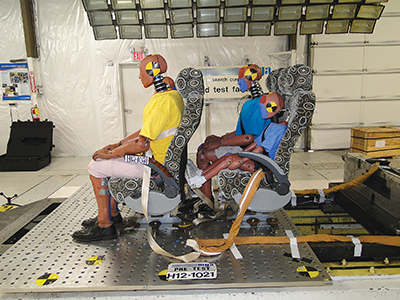Lap and shoulder belts aid maintenance
By Roberto Montoya
The need to provide greater protection for intercity and touring passengers has been a priority in recent years for the North American motorcoach industry. Years of analysis, testing and joint efforts between the National Highway Traffic Safety Administration (NHTSA) and various representatives of the industry have resulted in the regulated use of three-point passenger seatbelts.
The NHTSA issued the following statement in 2013, setting out the standards that must be met in passenger seats: “Beginning in November 2016, newly manufactured over-the-road buses and non-over-the-road buses with GVWR greater than 11,793 kg (26,000 lb.) will be required to be equipped with lap and shoulder belts for each passenger seat.”
 Relevant requirements:
Relevant requirements:
• Lap/shoulder-belt system for passenger seats to meet provisions for seat-belt adjustment and fit, so that the seat belts can accommodate children as well as large (95th percentile) adult males, are lockable for use with a child-restraint system, and are releasable at a single point and by a pushbutton action
• Seat-belt anchorages, both torso and lap, on passenger seats are integrated into the seat structure, so as not to impede emergency egress.
• FMVSS 210: The lap and shoulder belts must each hold a load of 3,000 pounds, all pulled simultaneously.
Amaya-Astron Seating is one of the first companies to invest, develop and adapt three-point seatbelts in many of its models. The development of the seats and their suitability required working together with OEMs to engineer both the buses and the seats. All seats with three-point seatbelts must be tested in certified laboratories in the U.S.
Regardless of tests conducted in certified laboratories, Amaya-Astron Seating has an internal laboratory that periodically ratifies the homogeneity and

strength of their seats in static tests, in order to ensure safety in production.
Strengthening the seat should not devalue the comfort and design. These factors are crucial for the passengers, who in recent years have been calling for a greater number of options that allow them to multitask and travel comfortably.
These are the six questions that every operator should ask before choosing a seat with three-point seatbelts:
1. What elements are critical to safe seating?
• The design must be robust. The seating system has to be designed, tested and built to withstand the use and abuse of the intended application.
• Consistency is key. The system has to be built so that every seat operates as it should.
• Ease-of-use – If the system is hard to use or confusing, people will not use it properly or simply not use it.
2. How much does a well-constructed seat help in an accident?
• Well-constructed seating can saves lives. If passengers wear seat belts, the chances of them being ejected from the vehicle are infinitely reduced than if they are unbelted.
3. What goes into the design of a safe seat?
• Years of experience and people committed to quality and safety and a process that is repeatable and reliable. The best manufacturers make sure their seats are designed in a manner that ensures safety is built into every model.
4. How is the seat tested in order to ensure its integrity?
• The best manufacturers test all of their seats to the applicable FMVSS / CMVSS requirements. Amaya-Astron also adds a 20-30 percent margin of safety on top of these requirements. Additionally, we cycle test our products to make sure that road fatigue and their repeated use over time will not cause any problems.
5. What is the average lifespan of a safe, well-constructed seat?
• A well-made coach seat should easily last seven years or more. However, it is good practice to inspect the seat regularly after five years. Make sure the belts are not fraying nor have any cuts.
6. What else should I ask?
• Make sure the seats were tested both on a platform and in-vehicle by an accredited testing facility.
Used motorcoaches
Remember this – The three-point belt integration standards apply only in November 2016 to new units and voluntary integration of old units. This leaves it up to the operators to carry out a retrofit on all of their earlier bus models. It is very important that the operator requests advice from the relevant OEM to verify that the bus is able to incorporate three-point belts.
The standard for the use of three-point seat belts is one of the most important decisions in recent years in the motorcoach industry. We are confident that this new regulation will help generate a cultural change in the safety of passengers every day.
Roberto Montoya is the leader of the Research and Development Department at Amaya-Astron, Cuautitlán Izcalli, Estado de México, Mexico. Visit Amaya-Astron online at www.amaya-astron.com.mx
